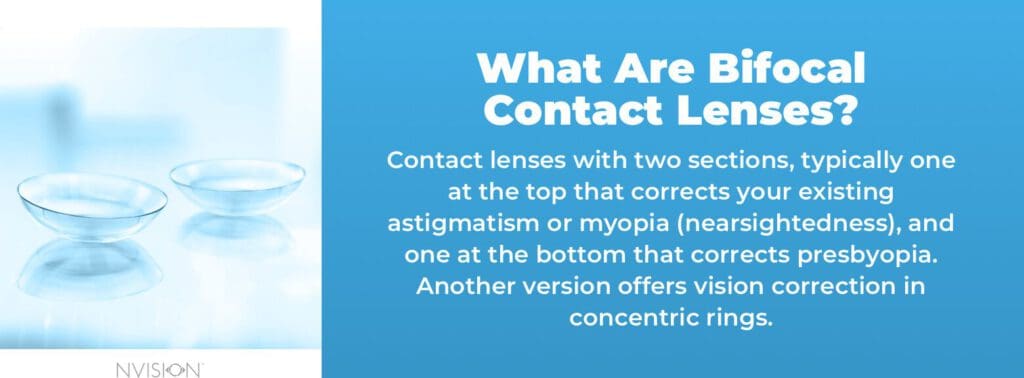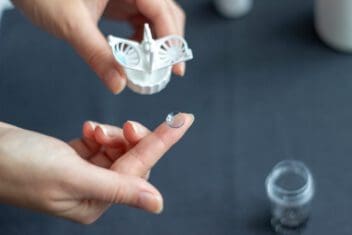Bifocal Contacts & Lenses: What They Are (Pros & Cons)
Home / Understanding Contacts /
Last Updated:
Bifocals are lenses with two sections, typically one at the top that corrects your existing astigmatism or myopia, and one at the bottom that corrects presbyopia. Bifocal contact lenses allow this correction without wearing specific glasses.
Table of Contents
Multifocal contacts also come in two types: one that mimics the lenses for glasses with a segmented upper and lower portion, and another with visual correction in concentric rings.
More people who wore contacts their whole adult lives are hitting middle age and older adulthood. This group may transition well to bifocal contacts. There is an adjustment period that can be uncomfortable, and you may never get the same level of vision correction with bifocal contacts as with glasses.
Bifocal contacts are more expensive than standard contacts. If you have vision insurance, your plan should offset some of that cost.

What Are Bifocal Contact Lenses?

Your eye doctor may diagnose you with a condition called presbyopia at a routine eye exam. This eye condition is a type of refractive error that occurs in middle-aged and older adults, typically around age 40 or older.
Presbyopia is similar to hyperopia, in that both conditions are farsighted. You struggle to see words or objects close to your face, but you can see clearly into the distance.
You deserve clear vision. We can help.
With 135+ locations and over 2.5 million procedures performed, our board-certified eye surgeons deliver results you can trust.
Your journey to better vision starts here.
People who have presbyopia develop this type of farsightedness due to the aging process in the eyes. It is a very common refractive error. It can develop even if you already have a refractive error like nearsightedness or astigmatism.
If presbyopia is your only refractive error, your optometrist or ophthalmologist may recommend a pair of reading glasses to help you perform close work. However, if you have an existing refractive error like astigmatism or nearsightedness (myopia), and you develop presbyopia, you may need a different prescription lens for your glasses.
Typically, these are bifocal lenses. This is a type of lens with most of the lens, or the top part of the lens, correcting the existing refractive error, and the bottom portion of the lens correcting presbyopia.
Bifocal lenses for glasses have existed for decades. As baby boomers age and require bifocals or even trifocals, contact lens manufacturers have developed comfortable and effective bifocal contact lens.
What Are Bifocals & How Do the Contacts Work?
Bifocal contact lenses are a type of multifocal contacts that correct both presbyopia and your other refractive error. These contacts have different zones with different powers that allow you to focus on several ranges. In the case of bifocal contacts specifically, you can focus on both near and far objects. In essence, they are like the lenses on bifocal glasses, but in a form that adheres to your cornea.
For a long time, if you wanted to wear contact lenses to treat an issue suited for bifocals, you had to wear different contact lenses in each eye — one to correct presbyopia and one to correct your other refractive error. You had to train your brain to see well with these lenses, and you risked losing the ability to judge an object’s distance or speed. Contacts that offer the same bifocal correction in both eyes are safer and easier to adjust to.
Because these lenses rest on your cornea, the corrective areas can work similarly to lenses on glasses, or they can be placed in a different part of the contact. There are basically two types of bifocal contacts.
- Segmented: These contacts are like bifocal lenses in glasses, with two distinct, sectioned areas — one in the top and one, for presbyopia, in the bottom. Since regular contacts can move around your eye, segmented contacts may be weighted so they remain in the right place, allowing you to look through the correct part of the lens when needed.
- Concentric or simultaneous: Rather than an upper and lower section, concentric bifocals have an outer ring that corrects one refractive error and an inner ring that corrects the other. Usually, manufacturers have a sharp barrier between these areas, so you can see when you transition from one to the other. However, aspheric concentric lenses have a gradual transition between near and distance vision correction. This can take some adjustment time, as you learn to see through them.
Pros & Cons of Bifocal Contact Lenses
Like other types of contact lenses, bifocal soft contacts are disposable. They come in daily wear options, meaning you wear a pair for just a day and then dispose of them; as monthly lenses, which are worn for up to 16 hours a day for a whole month, but not worn during sleep; and in other time increments, like a week.
To be fitted for bifocal contact lenses, your optometrist or ophthalmologist will ask you about your daily habits and routines, so they understand what you spend much of your time doing. If you have a long commute to work, for example, you may benefit from better correction for clear distance vision. If you spend more time reading or doing other work closer to your eyes, you may need your farsightedness better corrected, but distance vision can be lower.
While you may have achieved visual clarity from your previous contact lenses when they corrected your astigmatism or myopia, you are unlikely to have the same visual acuity with bifocals. However, your vision should be clear enough for most tasks.
- Pros: For people who enjoyed contact lenses for years and never wanted to wear glasses, bifocal contacts are a wonderful option to help them see clearly, without wearing something they may find stigmatizing. This seems to be especially true for the baby boomer generation. There are about 78 million boomers, and as a relatively healthy and young-acting generation, they do not want to appear “old.” Finding ways to eliminate the need for bifocal glasses or reading glasses can help them manage their changing vision.
Originally, the reported success rate for bifocal contact lenses was low, but a new generation of older adults is developing presbyopia. This generation has worn contact lenses much of their adult life. This consistency in contact lens use may improve how bifocal contacts feel for this group. One study reported that rates of bifocal contact success and satisfaction are between 67 and 83 percent.
One report suggested that increased use of laser in-situ keratomileusis (LASIK) would reduce the prescription rate for bifocal contacts. Boomers are undergoing LASIK to manage presbyopia and long-term refractive errors, but as the eye ages, developing presbyopia again becomes a risk. It may be better to manage mild or moderate refractive errors with secondary presbyopia with contacts rather than surgery.
- Cons: Even if you are used to wearing contact lenses, you may be unsatisfied with bifocal contacts. When wearing bifocal glasses, you can move your head or your glasses to adjust where your eyes are looking. With contact lenses, you may feel disoriented and develop eye strain or headaches during the adjustment period. Special fittings and prescriptions are needed to wear bifocal contact lenses, even if you already wear contacts to treat one type of refractive error.
After you have adjusted to wearing new lenses, you may still not get enough vision correction to see well up close or far away. This could lead to dissatisfaction with the experience overall.
Since contact lenses can dry out your eyes and cause more irritation, you may develop glares or haloes around lights, have trouble seeing at night, or feel an itching sensation in your eyes. Chronic dry eye is more likely in people who are 45 or older. Dry eye could exacerbate the discomfort you feel with these new contacts.
Bifocal Lenses & Contacts for Presbyopia Management

Your eye doctor may diagnose you with a condition called presbyopia at a routine eye exam. This eye condition is a type of refractive error that occurs in middle-aged and older adults, typically around age 40 or older.
Presbyopia is similar to hyperopia, in that both conditions are farsighted. You may notice you have presbyopia if you struggle to see words or objects close to your face, but you can see clearly into the distance. If you experience this, talk to your doctor.
People who have presbyopia develop this type of farsightedness due to the aging process in the eyes. It is a very common refractive error. It can develop even if you already have a refractive error like nearsightedness or astigmatism.
If presbyopia is your only refractive error, your optometrist or ophthalmologist may recommend a pair of reading glasses to help you perform close work. However, if you have an existing refractive error like astigmatism or nearsightedness (myopia), and you develop presbyopia, you may need a different prescription lens for your glasses.
Typically, these are bifocal lenses. This is a type of lens with most of the lens, or the top part of the lens, correcting the existing refractive error, and the bottom portion of the lens correcting presbyopia.
Bifocal lenses for glasses have existed for decades. As baby boomers age and require bifocals or even trifocals, contact lens manufacturers have developed comfortable and effective bifocal contact lenses.
You deserve clear vision. We can help.
With 135+ locations and over 2.5 million procedures performed, our board-certified eye surgeons deliver results you can trust.
Your journey to better vision starts here.
Are Bifocal Contacts Expensive?
When considering bifocal contact lenses, a common question that arises is, “Are bifocal contacts expensive?” The answer tends to be a bit more complex. Bifocal contacts are generally more expensive than standard contacts, reflecting the advanced technology needed to correct both near and far vision in a single lens.
The exact price can vary widely depending on factors like brand, materials, prescription, and where they are purchased. If you have vision insurance, it may offset some of this cost, making them more accessible. Despite the higher price point, many find bifocal contacts to be a valuable investment, especially as a convenient and aesthetically appealing alternative to wearing reading glasses or multiple pairs of contacts.
While the initial cost may be higher, it’s important to discuss your specific needs and budget with an eye care professional. They can guide you to the best solution for your vision needs, considering the unique benefits that bifocal contacts offer.
Popular Brands
These are popular bifocal contact lens brands and products:
- Alcon’s AirOptix plus HydraGlyde multifocal lens
- CooperVision’s Clariti 1-day multifocal
- Bausch & Lomb’s Ultra
- CooperVision’s Proclear 1-day multifocal
- Acuvue’s 1-day Moist multifocal
Bifocal Contacts FAQ
How hard is it to adjust to bifocal contacts?
It usually takes a week or two to adjust to these lenses. For some people, it may take longer, such as four to six weeks.
Are bifocal contacts harder to place in your eyes than standard contacts?
Bifocal contacts are placed in the same way that regular contacts are, but you may need to adjust them slightly to ensure the right portion is at the bottom of your eye.
Are bifocal contacts better than glasses?
Bifocal contacts work similarly to bifocal glasses, but since they rest directly on the eye, they offer more complete coverage. This can result in a better experience than when you wear bifocal glasses.
What are the cons of bifocal contacts?
The main negative associated with bifocal contacts is that they are more expensive than standard contact lenses.
You deserve clear vision. We can help.
With 135+ locations and over 2.5 million procedures performed, our board-certified eye surgeons deliver results you can trust.
Your journey to better vision starts here.
References
- Presbyopia. National Eye Institute (NEI).
- Presbyopia Treatment. (January 2020). American Academy of Ophthalmology (AAO).
- Other Types of Contact Lenses. (July 2019). National Eye Institute (NEI).
- Bifocal Contact Lenses. (July 2018). Michigan Medicine, University of Michigan.
- Top 10 Ways to Fail With Multifocal Contacts. (December 2011). Review of Optometry.
- Bifocal and Multifocal Contact Lenses. Science Direct.
- Bifocal Contact Lenses: History, Types, Characteristics, and Actual State and Problems. (December 2008). Clinical Ophthalmology.
- How Much Are Contacts? Acuvue.
- Multifocal Contact Lenses: A Bibliometric Study. (September 2020). Journal of Optometry.
This content is for informational purposes only. It may have been reviewed by a licensed physician, but is not intended to serve as a substitute for professional medical advice. Always consult your healthcare provider with any health concerns. For more, read our Privacy Policy and Editorial Policy.

